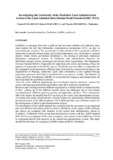Please use this identifier to cite or link to this item:
https://cris.library.msu.ac.zw//handle/11408/1917| Title: | Investigating the Conformity of the Zimbabwe Land Administration System to the Land Administration Domain Model Standard (ISO 19152): Paper presented at FIG Congress 2014, Kuala Lumpur, Malaysia 16–21 June 2014 | Authors: | Paradzayi, Charles Mapamula, Robert Mtariswa, Tinashe |
Keywords: | Land administration, Zimbabwe, LADM, conformity | Issue Date: | 2014 | Abstract: | Zimbabwe is emerging from both a political and economic slumber and authorities have since realised the role that Information communication technologies (ICT) can play in resuscitating the economy. The government recently introduced the e governance initiative which aims to provide citizens timely and accurate information. As a result there is renewed interest, within various government institutions in the existing or previously abandoned information management systems. In Zimbabwe, land administration functions are distributed amongst various government and private sector organisations. The Department Surveyor General (DSG) is responsible for supervising the survey and charting of land for purposes of registration in the Deeds registry. The Deeds registries office is responsible for the registration of all transactions affecting land while land use control and valuation is the responsibility of Planning Authorities. Land value information is also captured through registration processes when land is transferred from one party to another. The Ministry of Lands and Rural Resettlement (MLRR) is responsible for managing and administering all state land under the resettlement schemes.Over the years, different departments have developed separate electronic systems for storing and managing land information falling under their respective jurisdictions. However, data exchange between different organisations is mainly based on manual transfer of files. Linking up of the different systems poses big challenges due to the isolated conceptualisation, different operating systems and application softwares. This challenge has effectively limited the benefits that ICT can bring to the overall land administration system. A common data model should provide a holistic solution by harmonising different datasets and functionalities of the different players. The LADM provides such a reference model for the development of efficient land administration systems. The introduction of the LADM standard has coincided with the movement for an integrated and more efficient land administration system in Zimbabwe. In this paper LADM packages and classes are compared with elements in the current land administration system in Zimbabwe. Conformity of the current land administration system with the LADM standard (ISO 19152) is investigated. With a few exceptions, most classes in the LADM were found to correspond directly with elements in the current land administration system. This paper should form the basis for designing a LADM country profile for Zimbabwe. | URI: | http://www.fig.net/resources/proceedings/fig_proceedings/fig2014/papers/ts04c/ts04c_paradzayi_mapamula_et_al_7110.pdf http://hdl.handle.net/11408/1917 |
| Appears in Collections: | Conference Papers |
Files in This Item:
| File | Description | Size | Format | |
|---|---|---|---|---|
| paradzayi_mapamula_et_al_7110.pdf | Full Text | 341.88 kB | Adobe PDF |  View/Open |
Page view(s)
128
checked on Apr 4, 2025
Download(s)
96
checked on Apr 4, 2025
Google ScholarTM
Check
Items in MSUIR are protected by copyright, with all rights reserved, unless otherwise indicated.



